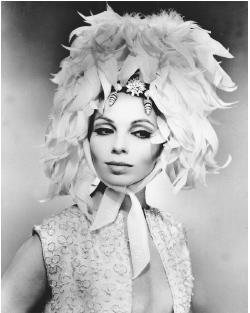Guy Laroche - Fashion Designer Encyclopedia
French designer
Born: La Rochelle, France, 16 July 1921. Career: Began working as a milliner, Paris; began working for Jean Dessés, became his assistant, 1949; traveled to the U.S. to study ready-to-wear manufacturing, 1955; established first Paris salon, 1956; opened Guy Laroche couture house and introduced ready-to-wear collection, Paris, 1961; created first fragance, 1966; added menswear line, 1966; second boutique opened, 1973; launch of additional boutiques, in France and elsewhere, 1974; designed last collection, 1989. Fragrances include Fidji, 1966; Eau Folle, 1970; J'ai Osé, 1977; Drakkar, 1972; Drakkar Noir, 1982; Clandestine, 1986; fragrance division sold to L'Oréal, company sold to Société Bic. Awards: Macy's outstanding creativity award, New York, 1959; Dé d'Or award, Paris, 1986, 1989; Chevalier de la Légion d'Honneur, 1987. Died: 17 February 1989, in Paris. Company Address: 29 Avenue Montaigne, Paris 75008, France. Company Website: www.guy-laroche.de .
Publications
On LAROCHE:
Books
Stegemeyer, Anne, Who's Who in Fashion, Third Edition, New York, 1996.
Articles
Parinaud, A. editor, "La Haute Couture intéresse-t-elle les peintres," in Galerie des Arts, March 1979.
"A chacon son Dé d'Or," in Vogue (Paris), February 1986.
"Guy Laroche á Bordeaux: le style de l'élégance," in Vogue (Paris), May 1987.
Obiturary, "France's Guy Laroche, Leading French Designer Dies," in Chicago Tribune, 18 February 1989.
Obituary, in the Daily Telegraph (London), 18 February 1989.
Obituary, in The Independent (London), 18 February 1989.
"Couturier Guy Laroche Dead at 67," in WWD, 21 February 1989.
"Un Dé d'Or au doigt de Guy Laroche," in Vogue (Paris), March 1989.
Benaim, Laurence, "Une griffe demeure: Guy Laroche un grand couturier," in Elle (Paris), 6 March 1989.
"Guy Laroche: l'album sur mesure," in Vogue (Paris), April 1989.
Premoli, Francesca, "The Realm of Illusion," in Casa Vogue (Milan),November 1989.
Beurdeley, Laurence, "Guy Laroche: l'esprit de la Renaissance," in L'Officiel (Paris), August 1990.
Givhan, Robin, "Nothing New Under the Paris Sun: Even the Best Doesn't Stand Out from the Rest," in the Washington Post, 12 March 1999.

——, "In Paris, Runway of Gossip; Show Wrinkled by Talk of Change," in the Washington Post, 8 October 1999.
***
Before entering the industry in the 1940s, Guy Laroche had no formal training in fashion design. He soon, however, built up a varied portfolio of experience, beginning with styling and millinery in New York followed by work in fashion and merchandising on Seventh Avenue. Returning to Paris he was offered a job as design assistant at the fashion house of Jean Dessés. Dessés was famous for designing the stole and distinctive draped chiffon evening gowns in striking colors. He also designed one of the first diffusion lines in 1950 and this marked the beginning of ready-to-wear in French haute couture. Laroche was involved in these innovations and in 1955 traveled to the U.S. to study new fabrication methods for ready-to wear.
Larouche opened his own couture house in 1956 on Avenue Franklin Roosevelt in Paris, at the age of 37. His first collection, shown in his apartment, was one of subtle sophistication, reminiscent of Balenciaga's restrained elegance: simple tops that spread into huge bouffant skirts with baroque inspired, twisted drapes, or relaxed short evening dresses in black silk chiffon, with elegant capes bordered in satin ribbon. Later collections were more feminine, fun, and younger in feel: short puffed hems and schoolgirl dresses or delicate gathered drapes and scallop-effect necklines. Guy Laroche clothes were particularly noted for their skillful cutting and tailoring.
By the early 1960s Laroche had launched a ready-to-wear line and opened a boutique. His reputation as a creative but shrewd businessman grew as his company expanded. Capitalizing on his following amongst actresses and socialites, the company moved swiftly into licensing and perfumes. The major perfume, Fidji, was introduced in 1966 to immediate success and the men's aftershave Drakkar Noir was introduced in 1982, to complement the previously established men's ready-to-wear clothing.
Licensed goods promoted the reputation of the Guy Laroche name internationally, particularly in the lucrative Middle Eastern markets where the allure of Paris on a label sold goods. Lingerie, nightwear, hats, ties, bags, scarves, and jersey knits were exported and sold in 250 boutiques worldwide.
During the late 1960s, Laroche sold a large amount of shares in his business to Bernard Cornfeld and to L'Oréal, the hair and beauty product manufacturers. The perfume side of the business then became a division of the L'Oréal beauty company. Licensing deals throughout Europe, Asia, and South America helped maintain a high profile for Guy Laroche products, including intimate apparel, footwear, luggage, sunglasses, and outerwear, while the company itself was later bought by French pen and razor manufacturer, Société Bic.
Guy Laroche, the legendary designer, died in 1989, while his company struggled under successive designers, including Michael Klein, Elber Albaz, and Ronald van der Kemp. Albaz, widely credited with rejuvenating the company, left to head up Yves Saint Laurent in 1997. Dutch designer Ronald van der Kemp was hired to succeed Elbaz, but was fired after this first collection was panned by fashion critics. By 1999 Bic announced its intention of selling Guy Laroche, due to falling profits and currency rate fluctuations. After the departure of Albaz, the company lost much of its sheen; subsequent collections were the product of a design team and lacked the élan usually associated with the name Guy Laroche. Yet in 2001 the Guy Laroche name was still alive and well, and Bic had, apparently, decided to hold on to its investment for the foreseeable future.
—Kevin Almond;
updated by Nelly Rhodes
Comment about this article, ask questions, or add new information about this topic: